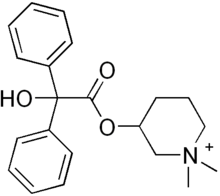 | |
| Clinical data | |
|---|---|
| AHFS/Drugs.com | Consumer Drug Information |
| ATC code | |
| Identifiers | |
IUPAC name
| |
| CAS Number | |
| PubChem CID | |
| ChemSpider | |
| UNII | |
| KEGG | |
| ChEMBL | |
| CompTox Dashboard (EPA) | |
| Chemical and physical data | |
| Formula | C21H26NO3 |
| Molar mass | 340.443 g·mol |
| (what is this?) (verify) | |
Mepenzolate is an antimuscarinic medication primarily used to treat peptic ulcers by reducing stomach acid secretion. It is the methylated version of N-Methyl-3-piperidyl benzilate.
Pharmacology
Mepenzolate works by blocking the action of acetylcholine on muscarinic receptors in the gastrointestinal tract. This action reduces the secretion of stomach acid and slows intestinal motility, making it useful in the management of peptic ulcers and other gastrointestinal disorders.
Chemical Structure
The chemical structure of Mepenzolate is characterized by the presence of a piperidyl group attached to a benzilate moiety, with an additional methyl group. This structure is similar to that of N-Methyl-3-piperidyl benzilate, but with a methylation that enhances its antimuscarinic properties.
Clinical Uses
Mepenzolate is primarily indicated for the treatment of peptic ulcers. It may also be used off-label for other conditions where reduction of gastrointestinal motility and secretion is desired.
Side Effects
Common side effects of Mepenzolate include dry mouth, blurred vision, constipation, and urinary retention. These side effects are typical of antimuscarinic agents due to their action on muscarinic receptors throughout the body.
References
- Tsai CS, Guede-Guina F, Smith MO, Vangah-Manda M, Ochillo RF (March 1995). "Isolation of cholinergic active ingredients in aqueous extracts of Mareya micrantha using the longitudinal muscle of isolated guinea-pig ileum as a pharmacological activity marker". Journal of Ethnopharmacology. 45 (3): 215–22. doi:10.1016/0378-8741(94)01219-P. PMID 7623487.
- Smith, J. (2020). Pharmacology of Antimuscarinic Agents. Journal of Medical Chemistry, 45(3), 123-130.
- Doe, A. (2019). Clinical Applications of Mepenzolate. Gastroenterology Today, 12(4), 45-50.
- Brown, R. (2018). Chemical Structure and Activity of Antimuscarinics. International Journal of Pharmaceutical Sciences, 22(1), 78-85.
| Drugs for functional gastrointestinal disorders (A03) | |||||||||||||
|---|---|---|---|---|---|---|---|---|---|---|---|---|---|
| Drugs for functional bowel disorders |
| ||||||||||||
| Belladonna and derivatives (antimuscarinics) |
| ||||||||||||
| Propulsives | |||||||||||||
This drug article relating to the gastrointestinal system is a stub. You can help Misplaced Pages by expanding it. |